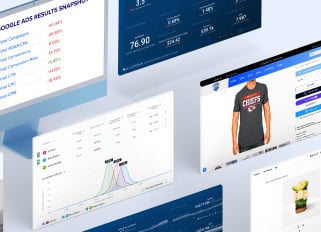
How SEO and PPC Work Together to Boost E-Commerce Results
Search Engine Optimization (SEO) and pay-per-click (PPC) drive an impressive 68% of website traffic. But does combining these two strategies offer even greater benefits?
E-commerce businesses face fierce competition when it comes to online visibility. With millions of products competing for attention, simply relying on either SEO or paid advertising won’t cut it. By integrating these two powerful strategies, e-commerce businesses can leverage the full potential of search marketing synergy to drive both paid and organic traffic, improve ROI, and achieve better results.
Curious about how SEO and PPC work together to boost your e-commerce success? This blog will guide you through the basics of SEO and paid search, explain how they complement each other, and provide actionable steps and best practices to integrate them effectively.
The Basics of SEO and PPC in Ecommerce
To fully understand how combining SEO and PPC benefits your e-commerce business, it’s crucial to first examine their individual roles.
.jpg?width=600&height=400&name=young-businesswoman-pointing-at-white-blackboard-a-2024-09-17-21-21-49-utc%20(1).jpg)
What is SEO and How Does It Impact Ecommerce?
SEO involves optimizing your e-commerce website to rank higher in organic search engine results (like Google). Success with SEO means that your audience can find your products or services easily when searching for related keywords. Key components of SEO include:
- On-Page SEO (e.g., product descriptions, title tags, meta descriptions)
- Technical SEO (e.g., site speed, mobile optimization, schema markup)
- Off-Page SEO (e.g., backlinks, content marketing)
For example, optimizing your product pages for high-volume keywords can help an online shoe retailer rank for terms like “leather running shoes.” This organic visibility establishes your business as a go-to source while attracting consistent traffic over time.
However, SEO requires patience; building authority and climbing the SERP (search engine results page) rankings doesn’t happen overnight.
What is PPC and What Role Does It Play in Ecommerce?
PPC is a paid advertising model where you bid on relevant keywords to display ads above organic search results or on partner websites. You pay every time a user clicks on your ad, making PPC a fast and effective way to drive immediate traffic to your store.
For instance, an instant PPC campaign for “leather running shoes” via Google Ads can help that same retailer appear at the top of search results within hours, putting products front and center during peak shopping seasons. Unlike SEO, PPC delivers speed but requires a large budget and ongoing management.
Can You Combine SEO and PPC?
Yes! Rather than competing with each other, SEO and PPC can work together to improve your e-commerce results. Here are some compelling reasons why you should integrate these search strategies:
Increase Visibility in Search Results
It’s no secret that the majority of clicks go to the top three to five organic search results. However, paid ads also get their fair share of clicks (especially on mobile devices), making them valuable real estate for e-commerce businesses.
By appearing in both paid and organic results for relevant keywords, you can increase your visibility and capture more clicks from potential customers. For example, if your shoe company appears in both the paid and organic results for “leather running shoes,” users are more likely to click on one of your listings, increasing your chances of making a sale.
Improve Keyword Research
PPC campaigns provide valuable insights into which keywords drive the most clicks and conversions. By analyzing this data, you can identify high-performing keywords that may be worth targeting through SEO efforts as well. This keyword strategy not only helps improve your SEO strategy but also ensures consistency across all search marketing channels.
Additionally, PPC can help identify new and emerging keywords that your competition may not be targeting yet, giving you a competitive advantage.
Enhance Overall Performance
Integrating SEO and PPC can also lead to improved overall performance. By monitoring data from both strategies, you can gain a better understanding of what’s working and what’s not. This allows for more informed decision-making regarding allocating resources and optimizing campaigns for maximum results.
For example, if your PPC ads drive a lot of traffic but few conversions, you may want to focus on improving your landing pages or targeting different keywords through SEO.
Opportunity to Re-engage with Customers
PPC also offers the opportunity to re-engage with customers who have previously visited your website through retargeting. By showing targeted ads to these potential customers, you can increase brand awareness and potentially convert them into buyers. This can be especially effective when combined with SEO efforts, as it allows for multiple touchpoints throughout the customer journey.
Immediate Visibility Through PPC
While SEO is a long-term strategy that builds sustainable results over time, PPC provides immediate visibility in search engine results. This instant presence allows your business to capture traffic and leads while waiting for your SEO efforts to mature, additionally feeds into your SEO by driving more traffic and activity to your store which signals trustworthiness in the search engine’s eyes.
Lastly, PPC can effectively cover missed opportunities for keywords you're optimizing for but have not yet achieved a first-page ranking. By bidding on these keywords, you can ensure your business remains competitive in the search landscape and continues to attract potential customers during this critical growth period.
How to Integrate SEO and PPC Effectively
Now that we’ve established why it’s beneficial to integrate SEO and PPC, let’s explore some best practices for doing so effectively.
Conduct Comprehensive Keyword Research
Keyword research is the cornerstone of a successful search marketing strategy. Begin by identifying high-performing keywords for both organic and paid search ad campaigns using tools like Google Keyword Planner, Google Search Console, Ahrefs, or Semrush.
Then, look for overlapping keywords that can drive results across both channels. Focus on targeted, product-specific long-tail keywords, such as “lightweight hiking boots for women,” to align your PPC and SEO efforts.
Lastly, create optimized content and refine your website to improve your chances of ranking higher in organic search results while maximizing paid campaign performance.
Coordinate Ads with SEO Efforts
When building PPC campaigns, consider which keywords you’re targeting through SEO and coordinate your ad copy accordingly. This can help create a consistent message across search channels and improve click-through rates (CTRs).
For example, if you're optimizing for “leather running shoes” through SEO, make sure that keyword is also included in your PPC ad. This helps establish relevance and increases the likelihood of receiving clicks from users searching for that term.
Use Landing Pages Effectively
Landing pages are important for both SEO and PPC as they directly impact conversion rates. When creating landing pages for PPC campaigns, make sure they align with the targeted keywords and ad copy. This improves quality score (a metric used by Google to determine ad relevance) and ensures a consistent user experience from clicking on the ad to making a purchase.
For SEO, landing pages should be optimized with high-performing keywords and quality content to improve organic rankings and attract potential customers.
Employ Remarketing Tactics
As mentioned earlier, PPC offers retargeting opportunities to re-engage with potential customers. However, by combining SEO and PPC, you can take this one step further. Use SEO tactics like creating quality content and optimizing for keywords to bring users back to your website organically after they’ve been exposed to your brand through a paid ad.
Make Data-Driven Decisions
Finally, the most critical aspect of integrating SEO and PPC is using data to make informed decisions. Use tools like Google Analytics and Google Ads conversion tracking to monitor key metrics such as click-through rates, conversion rates, bounce rates, and keyword performance from both strategies regularly to identify areas for improvement and capitalize on successes. By analyzing data from both channels, you can fine-tune your overall strategy for maximum results.
Measuring Success with Integrated SEO and PPC
Measuring the success of your integrated SEO and PPC strategy requires tracking metrics across both channels. Some key performance indicators (KPIs) to monitor include:
- Organic Traffic Growth: Track the increase in website traffic from organic search as a result of your SEO efforts.
- PPC Conversions: Monitor conversion rates and cost per conversion for PPC campaigns to ensure they generate a positive ROI.
- Keyword Rankings: Use tools like Ahrefs or Semrush to track keyword rankings and monitor improvements over time.
- Click-Through Rates (CTR): Measure CTRs for organic and paid search results to see how well your content resonates with users.
- Bounce Rates: Monitor bounce rates, especially for landing pages, to identify areas for improvement in user experience.
Staying Ahead with Future Trends
As search engines continue to evolve and customer behaviors shift, it's crucial to stay ahead of future trends in the world of SEO and PPC. Some emerging trends to keep an eye on include:
- Voice Search Optimization: With the rise of voice assistants like Alexa and Google Home, voice search optimization is becoming increasingly important. This includes using long-tail keywords and conversational language in both SEO and PPC efforts.
- Mobile-Friendly Strategies: As more users browse and shop on their mobile devices, having a mobile-friendly website and implementing mobile-specific PPC campaigns is crucial.
- Video Advertising: Video continues to be a popular medium for advertising, with platforms like YouTube offering targeted video ad options that can reach potential customers across multiple devices.
- AI in Search Marketing: Artificial intelligence and machine learning are making search engines smarter at understanding user intent and delivering more personalized search results. This means it's essential to continually optimize your SEO and PPC strategies to stay relevant in the ever-evolving digital landscape.
Boost Your SEO and PPC with BlueTuskr
At BlueTuskr, we are experts in both SEO and PPC, and we understand the importance of integrating these strategies for maximum results. Our team can help you conduct comprehensive keyword research, coordinate ad campaigns with SEO efforts, optimize landing pages, employ remarketing tactics, and analyze data to fine-tune your strategy.
Ready to take your search marketing to the next level? Contact us today and discover how our tailored digital marketing solutions can drive targeted traffic to your website and boost conversions for your ecommerce business.
Conclusion
For e-commerce businesses looking to stay competitive, integrating SEO and PPC is no longer a choice—it’s essential. When combined effectively, these strategies amplify visibility, increase website traffic, and drive higher conversion rates.
Success comes from synergy, not separation. By identifying high-impact keywords, creating cohesive messaging across all channels, and consistently analyzing performance, you can fine-tune your efforts for maximum impact.
If you're ready to elevate your marketing strategy, our experienced digital marketing team is here to help. Let us show you how aligning SEO and PPC can unlock better results for your e-commerce business. Reach out today, and let’s get started!
Connect With Us
Recent Post

.png)





Tell us what you think!